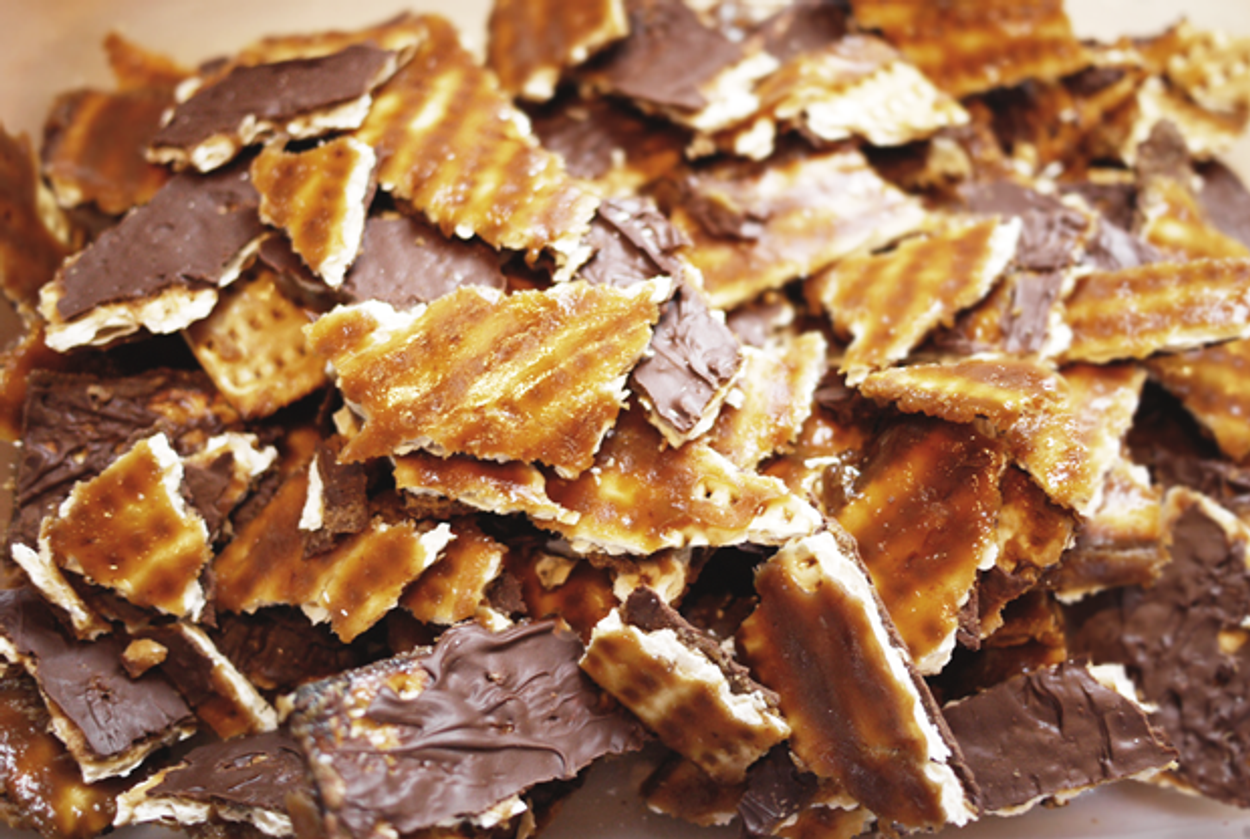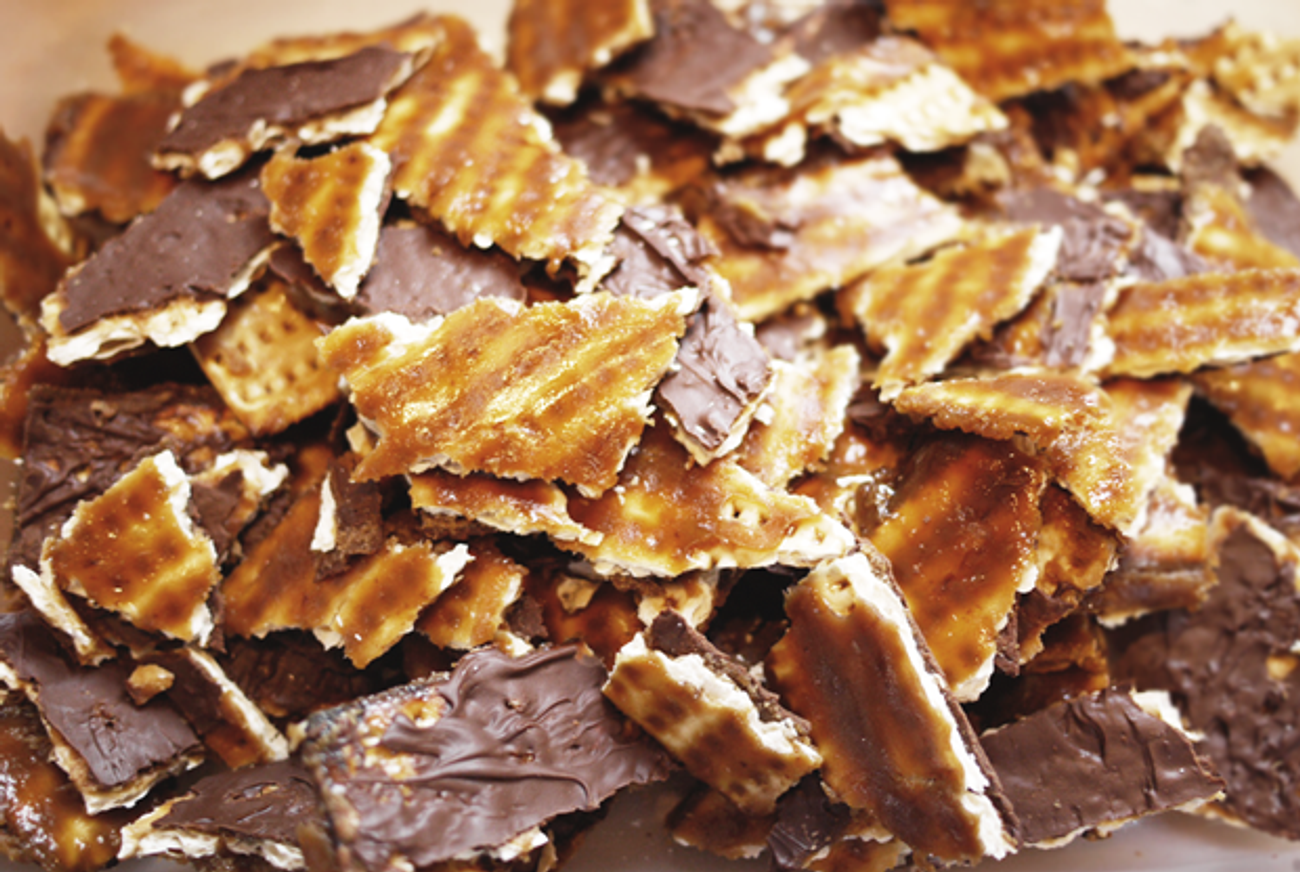A Passover Miracle: Turning Matzo Into Candy
The bread of affliction never tasted so good, thanks to Marcy Goldman’s recipe for caramel-covered buttercrunch




In 1985, Marcy Goldman unknowingly created a recipe that would become a staple of Passover kitchens from coast to coast. At the time, she was a freelance food writer and young mother in search of a Passover dessert that her toddler son, Jonathan, would enjoy. So she developed something that could woo the pickiest eater: matzo buttercrunch, a tantalizing candy made from caramel and chocolate swirled on top of pieces of matzo.
It turns out—and herein lies the source of her success and her angst—she wooed just about everyone else, too. In 1986, she published the recipe in The Montreal Gazette. Flash forward three decades, and Goldman’s matzo buttercrunch is among the most popular, and most copied, Passover desserts made by home cooks. Thanks to the viral nature of the Internet, it has become the holiday’s equivalent of the chocolate-chip cookie—a dish so simple, so brilliantly obvious, and so adaptable, it has in many respects, and to Goldman’s chagrin, transcended its original source.
When Goldman was first developing her Passover dessert in the 1980s, the category typically included an unappetizing rotation of eggy sponge cakes, tinned macaroons, and neon jelly fruit slices. “We had gotten used to making do with bad dessert and sort of groaning and shrugging our shoulders,” Goldman told me recently. “As a pastry chef and a mother, I thought I could do better.”
Her lightbulb moment came while making a recipe for saltine toffee that she clipped from Ladies’ Home Journal. As a base, the recipe used soda crackers, which are delicious but forbidden on Passover. Goldman had a hunch that the basic idea might transfer very well to Passover’s favorite cracker. Her suspicions were confirmed as her Seder guests raved, sneaked thirds from the dessert tray, and begged her for the recipe. “I now make three full boxes of matzo candy every year to make sure I don’t run out,” she said.
After the buttercrunch recipe ran in The Montreal Gazette, it quickly spread to other newspapers and magazines. Before long, it became something of a cult classic on Passover tables around the United States—a rare holiday dessert that people actually looked forward to eating. In 1998, Goldman included the recipe in her now classic cookbook A Treasury of Holiday Baking. She also began to see it show up in other cookbooks, sometimes with attribution, but often without.
The arrival of the Internet accelerated the recipe’s rise in popularity. In 2008, very slightly modified versions were published (with nods to Goldman) on two popular food websites, The Kitchn and the blog run by Paris-based pastry chef David Lebovitz. The next year, Deb Perelman of the influential food blog Smitten Kitchen published a recipe for Chocolate Caramel (Crack)ers that included both the saltine and matzo varieties and referenced Goldman via Lebovitz.
“If you are hosting a Seder, you could sweat over making a ton of fancy, complicated desserts, or you could make this and it disappears in five minutes,” Perelman said of the dish’s appeal. “That should be the goal of all cooking.” The post garnered 377 comments, and from there the recipe jumped headfirst into mainstream.
Today, recipes for matzo buttercrunch can be found on numerous blogs and food websites including Food & Wine, Martha Stewart Everyday Food, and, of course, Goldman’s own website, Better Baking.
The dish goes by many names: matzo toffee, matzo brickle, matzo bark, matzo crunch, and, thanks to its highly addictive nature, matzo crack. Riffs and variations abound, from a sprinkling of sea salt or chopped nuts, to “matzo crack S’mores,” which sandwich a toasted marshmallow between two pieces of the candy, and the very un-kosher “Chocolate Bacon Matzo Brittle.” (For full disclosure, my own new cookbook, Modern Jewish Cooking, includes a recipe for caramel chocolate matzo clusters that merges Goldman’s dish with the matzo clusters a family friend brings to my in-laws’ Seder.)
Goldman finds all the attention gratifying. After all, she created a recipe that managed to break into the seemingly closed canon of “classic” Jewish dishes. (Her honey cake recipe has also become a perennial favorite for Jewish home cooks.) But she admits that she gets protective of her creations. “I have had people come up to me and say, ‘Oh, you’re a pastry chef. I have something you’ll love,’” she said. “And then they begin reciting my own dish back to me.”
Food, of course, is a social medium. Recipes have always been enjoyed communally and shared between friends and family. This is particularly true in the world of Jewish holiday cuisine, where family recipes get lovingly passed down through the generations.
“Ultimately, there just aren’t that many original ideas,” said Dianne Jacob, who runs the blog Will Write for Food and wrote a book of the same name. “Just because your grandmother handwrote a recipe on an index card does not mean it didn’t first appear in Good Housekeeping.” At a certain point, a genuinely successful dish like matzo buttercrunch (which itself was a substantial riff on an existing recipe) moves beyond its creator and enters the public consciousness.
***
A problem arises, however, when the benign act of recipe sharing begins to encroach upon someone’s professional domain. “I think people don’t really understand that developing recipes can be an occupation,” Jacob said. “When someone comes up with something really novel, they have pride in it. So, it’s difficult to see the recipe show up everywhere unattributed to them.”
Goldman approached Manischewitz a number of years ago about selling them the rights to use her matzo buttercrunch recipe. She got no response, she said, but a few years back, an uncredited recipe for “chocolate caramelized matzo crisps” began appearing on the company’s matzo boxes.
It is not legally possible to copyright a recipe, which means a food writer is left powerless if another writer or, say, a large food company, reprints their work. “People send me church and community cookbooks all the time, and nothing is ever credited to its original source,” said Perelman, who over the years has become a champion of recipe attribution on her blog. “It’s when you start looking at cookbook and magazine sales and who is getting paid that it becomes an issue.”
In 2003, Goldman began charging readers $2.49 to download recipes from her Better Baking website. (Some, including the matzo buttercrunch, she publishes for free.) “Everyone was vacuuming up my recipes and putting them on sites like Allrecipes.com, sometimes changing the headnotes, sometimes not,” she said during an interview for Jacob’s blog. “It was irksome.” The move proved unpopular with some readers, who have gotten used to the “everything free, all the time” mentality of the web.
Goldman continues to charge for her recipes today, though she understands it is largely a symbolic gesture. “It is a way to value my work,” she explained. “But ultimately you have to learn to roll with the punches and realize your reputation is bigger than any one recipe.” She has also found ways to get creative.
This summer her son Jonathan—the same one she developed her Passover treat for when he was a toddler—plans to open a restaurant called the Red Bird Cafe in Montreal, where they both live. The menu, which Goldman is helping to develop, will largely focus on healthy fare, but will also feature many of her classic desserts. “You can be sure we will offer matzo buttercrunch around Passover, if not year-round,” she said. Recipe appropriation may be a frustrating reality of the food writing business. But in the case of her son, Goldman is unequivocally proud.